Sighthounds are one of the most structurally functional groups of dogs for a specialised purpose. Their purpose is to sight, chase, and run down game. The Greyhounds and Whippets have been further developed for speed to race competitively. Structurally, sighthounds are true athletes. They have been selectively bred for those attributes that produce speed, strength, agility and quick reflexes. Many were developed to hunt a specific animal e.g. rabbits, deer, wolves etc. and over different types of terrain and this helped determine their size and structural characteristics.
Common traits among sighthounds are heads that are long and lean, bone is thinner, lighter and flatter yet still strong; the body is narrower, bodies are flexible and elastic as well as longer to increase stride length at the gallop. The heads of sighthounds are, as stated, long and lean with tremendous strength of underjaw -designed to hold and kill their prey. Most the eyes are oval, almond or triangular and set at an angle. The exception to this is the Rhodesian Ridgeback which has round eyes, but he also has a head unlike any of the other sighthounds. And remember he was bred to protect as well as hunt. |
 |
Generally, the body of sighthounds is lean in outline with a definite tuck up, yet well covered with muscle. Muscle mass is increased in the rear quarters, through the topline and forequarters to add speed and strength to deal with the stresses created by high speed and quick turns. Muscling is long and strong, not thick, bunchy or under developed.

Tucked |

Extended |

Live Dog |
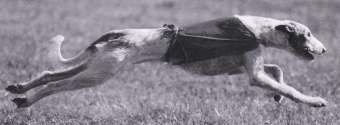
Coursing |
|
Sighthounds utilize the double suspension gallop, the swiftest of canine gaits, with speeds up to 40 mph in the Greyhound and 35 mph in the Whippet. There are two periods of suspension in the double suspension gallop, when all four feet are off the ground. One phase is when the dog is completely tucked up with the topline curved; the other phase is when the dog is completely extended with the topline flattened and the entire body almost parallel with the ground. This extreme flexibility is not possible without strong musculature over the back and loin to bow and straighten the body. Pasterns must be strong; yet elastic, as during the double suspension
gallop, the pastern is incredibly bent, laying flat on the ground. Its strength helps to break the falling motion of the dog as well as help it spring upward. Also you will find that most sighthounds will be noticeably and functionally wider in the hindquarters than the forequarters. This is necessary for the double suspension gallop.
As in all dogs, sighthound structure begins with the skeleton, which is held together by muscle, ligaments, and tendons. Instead of being solid, the skeleton is articulated and gives at a great number of points and in various directions. To a large extent, the musculature determines how a dog will move. In addition other factors such as attitude/temperament, general health and physical condition will influence movement. The skeleton is important, but remember that the most perfect bone structure is worthless without adequate muscle to make it function properly. The skeleton provides the basis for support and the muscles, ligaments, and tendons create the action of movement among the various parts of the dog. The skeleton and musculature must be strong enough to deal with stresses that are as strong in an upward, lateral or downward direction.
The sighthound's forelimb is used for thrusting upward and for forward propulsion. The shoulder/scapula is connected to the thoracic vertebrae by muscle, much like a sling. Each front leg is independently suspended by muscles.

Steep Angulation |
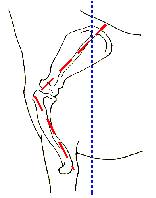
Moderate Angulation |
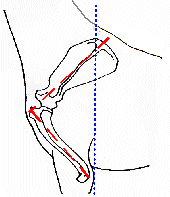
Well Laid Back |
|
The persistent belief that a 45 degree shoulder angle is desirable on sighthounds has been disproved by a number of authorities, e.g. Rachel Page Elliott, Curtis Brown, Connie Miller. Quoting Rachel Page Elliott "A 45 degree slant, or layback, would be workable if the blade were a stationary bone with a more or less fixed joint from which the upper arm moved forward and back. But this is not the case. What we have failed to recognise is the great mobility of the shoulder blade as a partner to the action of the upper arm, which serves as a lever in lifting and transporting the central body forward as smoothly as possible". Because of the extreme mobility of the shoulder, forward motion is not determined by the standing angle as previously thought.
This is not to approve of a very straight shoulder however, as it is incorrect. Exact degree measurements of the shoulder are not necessary. Instead, just categorise the sighthound's shoulder angle as either straight, moderate (approx 70 degrees off the level or 20 degrees off the vertical) or well laid back (approx 60 degrees off the level or 30 degrees off the vertical). It is very difficult to determine exact shoulder angle without proper equipment, and the angle will vary from moment to moment with the tiniest posture change of the dog. The length of the upper arm should be at least as long as the shoulder blade. The Ibizan Hound Standard calls for a rather steep, short shoulder blade, but he should still have an upper arm as long as the shoulder blade as his elbow is required to be about 2½ to 3 inches below the ribcage.
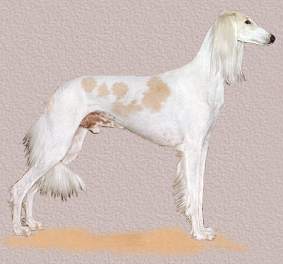 |
You will find that some of the sighthounds, such as the Greyhound, Whippet and Saluki will most likely have some width between the blades at the withers, as they need to be able to lower their heads on the run. Some breeds, such as the Borzoi and the Deerhound would not require such width as they were bred to hunt large game instead of having to scoop up small prey. Speaking of the Borzoi, do check for bone as they are required to have blade bone. |
The body of the sighthound should be supple and have great freedom of motion. A long body is an aid where there is much bending of the trunk. A long body is obviously a speed adaptation in the Greyhound and Whippet; however, in some of the sighthounds, e.g. the Afghan, Basenji and Pharaoh Hound, a shorter, squarer body is desirable where agility and endurance are critical. It takes more energy to bend and straighten a long body.
Sighthounds resembling the Greyhound prototype have a topline with a noticeable arch. This arch should not start at the withers. It actually begins in the thoracic region, after the anticlinal vertebrae where the vertebrae change direction from pointing backward to forward. Beyond the anticlinal vertebrae, the vertebrae point forward. This change in direction of the spines creates a slight "dip". This dip is normal; however, an accentuated dip is incorrect. This arch is most obvious in the lumbar area of the topline. The highest point of the arch should not be any higher than the highest point of the withers. In sighthounds, underline is just as important as topline. Curtis Brown states, "During swift galloping, when the flexible back is used, a stomach without a tuck-up hinders spine flexing. It is the sighthounds and other breeds designed for swift galloping which should have a tuck up". |
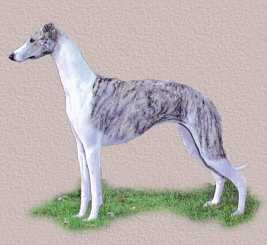 |
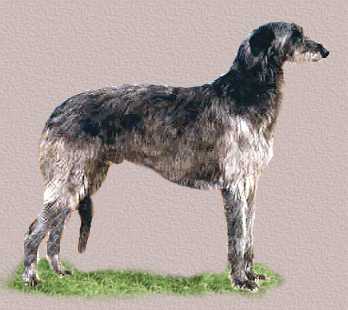 |
The angle of the pelvis helps to determine the ability to extend the hindquarters behind the body in conjunction with the musculature. If the pelvis is steep, the hindquarters are usually restricted in their backward extension. In his book "Speed in Animals", A Brazieir Howell observed that adaptations for speed involve the hind limb more frequently than the forelimb. Hindquarters provide more of the forward propulsion at the gallop. Sighthound hindquarters are well constructed for speed and suited for leaping. |
When viewed from behind, the hindquarters are muscular, carrying down to the hock. When viewed in profile, the upper and lower thigh should be broad with noticeable muscling.
The rear angulation is the relation of the upper thigh (femur) to the second thigh (tibia). The ratio should be 1:1. Excessive angulation is a detriment to the sighthound as it requires excess energy to move. A moderate bend of stifle is called for in the Basenji, Pharaoh Hound and Saluki Standards while the Ibizan Hound calls for hindquarters with no great angulation.
Although the trot will not reveal galloping ability, it is the only practical way to determine how the limbs move, whether they are co-ordinated, properly made, balanced, healthy and conditioned.
The trot is a natural gait in sighthounds and they should be efficient at it. They have a lighter trot with more spring than non-sighthounds. It should not be laboured or plodding. When viewed on the down and back, the sighthound's movement will converge toward a centre line. The legs should remain in a straight line from the hip to the foot.
Now to the Utility Hounds or multi purpose hounds.

